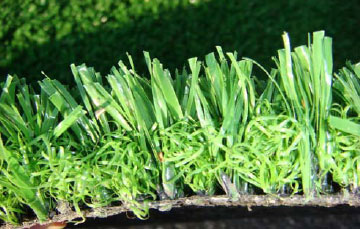Mapping, emissions and environmental and health assessment of chemical substances in artificial turf
1 Introduction
1.1 Artificial turf pitches are popular
In recent years, it has become increasingly popular to use artificial turf as a substitute for natural turf.
Artificial turf is becoming increasingly popular for golf greens, school playgrounds and playgrounds in general, but it is primarily used for football pitches.
The international football associations UEFA and FIFA thus accept the use of artificial turf pitches for football if the pitches meet the requirements for functional properties in relation to football (FIFA, 2006).

Figure 1.1 Outdoor artificial turf football pitch
There are several advantages in using artificial turf rather than natural turf. Artificial turf pitches are more hard-wearing and easier to maintain than natural turf pitches. The football season can be extended whatever for the weather, and the pitches can be laid in places where it is difficult to get grass to grow.
Artificial turf pitches are used indoors as well as outdoors. In Denmark, however, artificial turf pitches are almost exclusively used outdoors.
According to the Danish Football Association (DBU) (A. Johansen, 2007), there are four indoor pitches in Denmark. However, only two of these are third-generation pitches. One is a three-quarter pitch in Brøndby; the other is a newly installed pitch in Ikast. The infill material in Ikast is polyethylene-coated sand, contrary to the traditional third-generation pitches where the infill is sand plus an elastic granulate.
The sports arenas Valby-hallen and Ballerup-hallen also feature indoor pitches, but according to DBU, these are of the second-generation type (without elastic infill).
According to DBU, there are no immediate plans to establish further indoor pitches in Denmark.
In most cases by far, artificial turf consists of plastic fibres attached to a polypropylene or polyester carpet loom (see Fejl! Henvisningskilde ikke fundet.). The polyester mesh is coated with an adhesive suspension which is cured in an oven. One supplier mentions that a styrene butadiene latex is used for the adhesive.

Figure 1.2 Mesh for artificial turf, front and back
The fibre height is typically 3-6 cm. A mixture of sand and an elastic granulate is used in order to secure the artificial turf pitches. The sand is used because of its weight, and the purpose of the elastic granulate is to provide springiness.
Pitches using an elastic granulate as the springy part of the concept are called third-generation artificial turf pitches. Third-generation artificial turf pitches have been developed from 1990 to the present day.
A fourth-generation artificial turf pitch is also on the way, where an additional foamed elastic sublayer immediately below the turf structure is introduced. This makes it possible to reduce the volume of rubber granules per square metre, thus making it possible to use alternative elastic infill materials, such as ethylene propylene diene rubber (EPDM), at a competitive price (T.V. Pedersen, 2007). However, it does not give better playing properties compared to the other pitch types.
The concept of fourth-generation artificial turf pitches has not yet been defined by DBU.
In Magglingen, Switzerland, an artificial turf pitch has been laid on a pad without the use of elastic infill. The grass (PE) is held upright using polyamide support fibres.

Figure 1.3 PE grass with polyamide support fibres
However, according to the information available, this pitch does not meet the applicable FIFA requirements for playing properties. The requirements were made with a view to the properties of pitches with elastic infill, which was state of the art at that time.
Since then, and practically without exception, rubber granules from obsolete car tyres (styrene butadiene rubber (SBR)) have been used as the springy part of the infill material. This is due to the fact that, so far, tyre granules have been by far the cheapest infill material. Tyre granules are available as a raw material in ample supply, as approx, 60% of all rubber (approx. 20 million tonnes per year) is used to produce tyres which are discarded sooner or later. For a third-generation football pitch, approx. 100-120 tonnes of rubber granules are used. However, this volume can be reduced by installing an elastic pad under the mat on the reverse of the artificial turf.
Coated infill types also exist. The coating is typically polyurethane with an added colourant (e.g. green).
Tyres contain a number of chemical substances which are cause for health and environmental concerns, which means that rubber from discarded car tyres should be used with care.
This aspect, combined with the fact that the use of artificial turf has become increasingly popular, has resulted in several countries launching research projects designed to investigate the health and environmental impacts from artificial turf pitches (T. Källquist, 2005; C. Dye et al., 2006; T.S.W. Plesser, 2004; T. Sanner, 2006; Swedish Chemicals Agency (Kemikalieinspektionen), 2006; H.J. Kolitzus, 2006; Verschoor, 2007; M. van Bruggen et al., 2006; U. Hofstra, 2007; R. Moretto, 2007). The results of these projects will be briefly reviewed in chapter 3. Chapter 2 reviews the chemistry relating to the materials which are used to make artificial turf pitches.
Chapter 4 describes the mapping of the use of artificial turf pitches in Denmark. Chapter 5 follows, containing descriptions of sample materials procured in the form of artificial turf mats, infill materials and pads.
Chapters 6 and 7 deal with analysis methods and analysis programme and the health assessment, respectively. The report concludes with chapter 8 with an environmental assessment.
Version 1.0 October 2008, © Danish Environmental Protection Agency